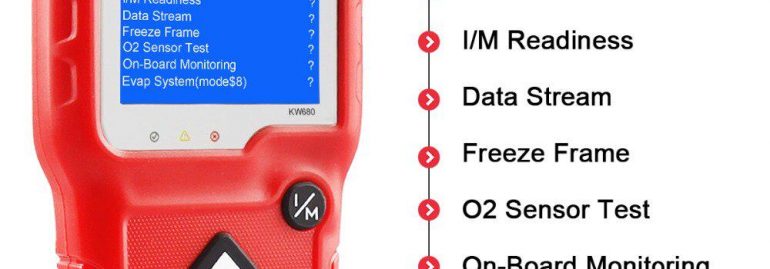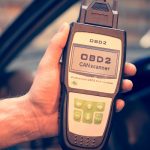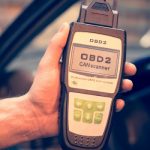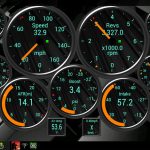The check engine light is a sign that something is wrong with your car. It indicates that there may be a problem with your car’s engine management system or another component. It displays a code known as Diagnostic Trouble Codes (DTCs) which are five digits long and describe a particular problem with the car. When you connect a scanner to your car’s OBD system, you will see the codes displayed on the screen. Each five-digit DTC represents a specific problem in your car and can help you determine if the problem is serious or not.
OBDII codes
OBDII automobile scanner codes are defined by a letter prefix and four numbers. These codes are retrieved by a scan tool and help the mechanic troubleshoot problems with the car. The first numeric digit indicates the type of code. The second and third digits represent a system of the vehicle. The last two digits specify a fault designation. Typically, an OBD code can be one of four different types.
To determine which type of OBDII automobile scanner is right for your vehicle, you’ll need to know its wiring diagram and its connection port. Most models will have an OBD port under the dashboard or on the steering wheel column. Some vehicles may also have ports in areas four through nine. OBDII automobile scanners can display diagnostic fault codes in numerical order and may even include a definition of the codes. When using a scan tool, it is vital to write down the code and the diagnosis.
Using an OBDII automobile scanner can also identify the general cause of a lit Check Engine Light. This code will consist of a series of numbers and letters. Each character is a single digit, ranging from 0 to nine. You can also find pairs of numbers from 00 to 99. The first three characters of a code are the vehicle fault number. The fourth and fifth characters represent the problem, while a pulse is a pause.
In addition to the letters and numbers, OBDII automobile scanner codes are categorized into different categories. Some codes indicate transmission-related problems, while others are related to sensor failure. However, there are some exceptions to the rule. Listed below are some common types of OBDII codes and their meanings. If you are unsure about which codes you need to interpret, read the owner’s manual carefully before performing a repair.
The OBD-II system constantly monitors the performance of the vehicle’s engine and its Emissions Control System. If there is a problem with one or both of these components, it will send an alert to the Check Engine Light. If the emissions produced by your car have exceeded Federal emissions, the Check Engine Light will come on. The OBD-II system connects to a 16-pin connector, called the Diagnostic Link Connector (DLC). It can be located in the vehicle’s engine or on the dash under the steering wheel. If you don’t know where the DLC is, the message may appear.
MAP sensor readings
If you’ve noticed that your MAP sensor reading is high, you should check the MAP sensor. It can indicate several problems with your car’s engine, including a malfunctioning sensor. The MAP sensor measures the amount of air in your car’s engine and relays its data and voltages to the ECU. You can test your MAP sensor by using a car scanner tool. A scan tool’s screen will display your vehicle’s MAP sensor reading and other related information, including its voltage, speed, engine load, and barometric pressure. The MAP sensor will read higher when the engine is running and lower when the engine is not.
You can troubleshoot MAP sensor issues by checking if the sensor is attached to the engine air intake. First, make sure that the wiring is not bent or disconnected. Secondly, make sure the MAP sensor is connected to the electronic control unit or engine control module. If you have a hard-core mechanic, you can try putting a jumper harness on your car’s MAP sensor. The sensor will send 5 volts down the signal wire if it is attached properly.
Another way to test the MAP sensor is by changing the air pressure. When your engine is idling, the air pressure in the car’s engine will drop by about 20 psi. Your automobile scanner will show a reading of 8 to nine inHg, which is the outside barometric pressure. You should check this reading with the current barometric pressure at your local weather channel or website to ensure that it is correct.
If your vehicle has a faulty MAP sensor, you will notice poor fuel economy. In addition to causing your engine to run lean, it can also cause your car to stall. If you use power steering, the engine will also die out. A failing MAP sensor can even make you fail your vehicle’s emissions test. With a car scanner, you can check this code and fix the problem.
PDTCs
PDTCs for automobile scanner codes refer to persistent fault codes. Unlike temporary codes, these cannot be cleared by standard means. They need to be cleared by running the car through sufficient cycles. The car’s sensors need to register new readings in order for a PDTC to be cleared. When the vehicle has reached the required cycle count, the check engine light turns off. A technician can then perform a diagnostic checkup.
In general, OBD2 codes have five characters. The first two characters are the starting code, which is usually a one or a zero. The second character is a two-digit number, which identifies a specific circuit or system. Depending on the vehicle, you may be seeing OBD II codes, which monitor the fuel-to-air ratio in the engine. Another type is the fuel-injector code, which has to do with the vehicle’s fuel injectors. The fourth and fifth characters complete the DTC.
PDTCs are stored in the OBD system, where they will be evaluated in determining a vehicle’s Smog Check inspection results. As of model-year 2010, these codes are stored in the OBD system. As a result, vehicles with PDTCs will fail Smog Check inspections. Thankfully, these codes are not harmful to drivers. Instead, they are a warning that something is wrong with the car.
Some vehicles can’t even pass the self-diagnosis test without a code reader. They will show the check engine light on when they detect a problem. Fortunately, there are resources available to help drivers fix these problems. PDTC training videos can provide additional information to Smog Check technicians and repair technicians. And they’re free! If you’re looking for a good automotive code reader, there’s a great chance you already have one. There are many different kinds of codes that can cause problems in your vehicle.
While it may not be the worst thing you can happen to your vehicle, you should definitely perform a diagnostic check to determine the cause. In many cases, a PDTC will not go away on its own. It will need to be repaired to clear it. But it will remain on the dashboard for a while until enough data is stored in the computerized car management system. If you do need to get your car inspected, the PDTC codes will help you in determining the problem.
Troubleshooting
Having trouble with your vehicle? Having trouble with diagnostic trouble codes (DTCs)? You’re not alone! There are numerous resources to help you figure out what the trouble codes mean. Some codes are pending and some are permanent. The purpose of these codes is to help diagnose the problem in your vehicle. Listed below are the most common and most useful codes to look for in your car. Once you have identified what the DTC means, you can fix it!
DTCs stand for Diagnostic Trouble Codes, which are five-digit codes that tell you what is wrong with your vehicle. The first digit in the code indicates manufacturer-specific codes, while the second digit represents generic codes. For instance, a code starting with P0 indicates a powertrain problem, while one starting with P1 is a mass air flow sensor (MAF) problem. If you suspect your car is experiencing one of these codes, the best way to fix the problem is to replace the faulty part or reconnect the fuel supply.
In most modern vehicles, the computer in the car controls all aspects of the vehicle, from its engine to its emissions. To identify problems, the computer sends the car a trouble code, which explains what is wrong. Trouble codes are often categorized into four main categories: body (B-codes) and chassis (C-codes). The powertrain (P-codes) covers the engine, transmission, and associated drivetrain accessories. In addition, network & vehicle integration (U-codes) code codes are used to diagnose problems with shared computer systems and network wiring in vehicles.
Some code readers also require that you connect the scanner to the vehicle’s ignition or engine. This connection is used to connect to the vehicle’s ECU. The scan tool will also ask for details about the vehicle such as model and year. Then, the code reader will show the DTC fault codes (or diagnostic trouble codes) in numerical order. Some even allow you to write down the definition of each code. After you’ve determined what type of trouble code you have, you can start the troubleshooting process.






